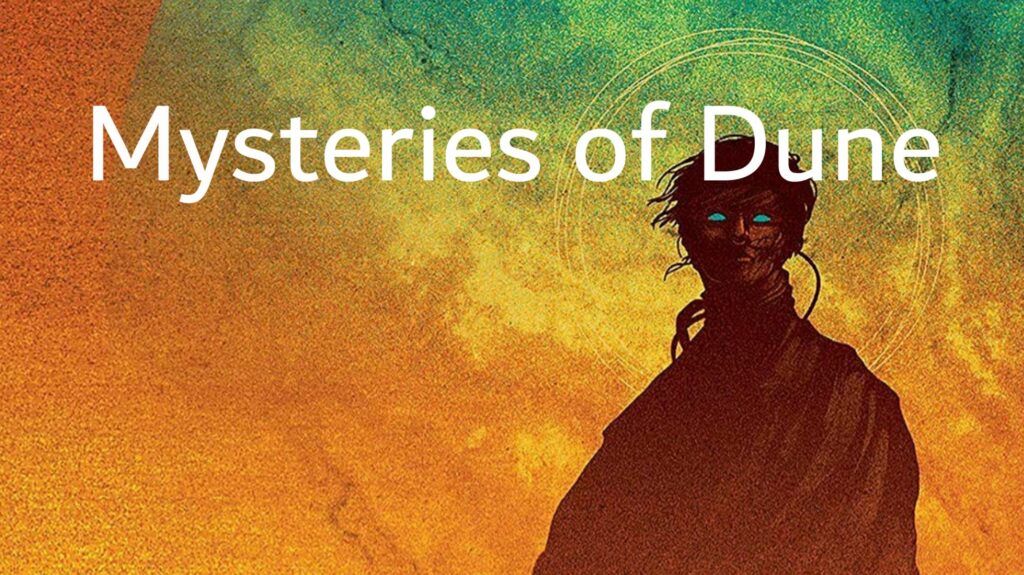My first YouTube video entitled ‘Mysteries of Dune’ has been posted, just in time for the 10th anniversary of this blog. The video if about the 5 most enigmatic mysteries within the Dune Saga written by Frank Herbert. Below you can read the full script, enjoy!
Intro
Welcome to the first YouTube video of SciFiEmpire. In this video I will discuss 5 of my favorite mysteries that exist in the Dune universe. There are many more. After all, the original saga spans 6 novels. But I chose five.
The Dune saga by Frank Herbert is filled with mysteries. Most are eventually explained. Yet some quotes and references made by characters not only pass by the people they were spoken to but also the reader. Dune is not always easy to understand. Author Frank Herbert expounded on a number of personal philosophical ideas. Most notably with Leto II’s Golden path, which forms the central plot thread throughout the saga but which can be hard to understand. Some mysteries within the Dune saga endure, in part because of the authors premature death in 1986. In this video I discuss five such mysteries and I attempt to provide a possible explanation.
Let’s start with the first.
Mysteries of Dune #1
Why was Leto II afraid of the Great Spice Hoard?
In the novel God Emperor of Dune, a quote from the Lord Leto prefaces every chapter, much like those of Princess Irulan do in the original Dune novel. About two-thirds into the story we get the following quote, attributed to Leto’s Stolen Journals.
“You know the myth of the Great Spice Hoard? Yes, I know about that story, too. A majordomo brought it to me one day to amuse me. The story says there is a hoard of mélange, a gigantic hoard, big as a great mountain. The hoard is concealed in the depths of a distant planet. It is not Arrakis, that planet.
It is not Dune. The spice was hidden there long ago, even before the First Empire and the Spacing Guild.
The story says Paul Muad’Dib went there and lives yet beside the hoard, kept alive by it, waiting. The majordomo did not understand why the story disturbed me.”
This quote together with sudden character changes start the final act of the novel. But why would this little tale disturb the prescient God-Emperor so much? The answer lies within the purpose of the Golden Path as envisioned by Leto II. The Golden Path was an enforced era of tranquility lasting nearly 3500 years. From the end of novel Children of Dune to the end of God Emperor of Dune. During which there were ever fewer wars, but also less human achievement, commerce and notable historic moments. The larger powers players such as the Great Houses were much reduced in influence and wealth. The Bene Gesserit sisterhood, the Spacing Guild and to a lesser degree the Ixian technocracy all had a hard time maintaining the influence they previously had.
On most planets humanity was reduced to a pastoral existence with the God-Emperor ruling from Dune. The threat posed by his Fishspeaker legions and fear of reduced spice quotas prevented most conflicts. All this had a purpose, as the God Emperor Leto II explains multiple times throughout the novel. Besides the steady progression of his own genetic breeding program, it forced introspective onto humanity. Once the rule of the God-Emperor was over humanity would explode into the universe. Shortages of spice would force humanity to find other sources. Explosive growth in births and the use of thinking machines would help that process along.
This period of time is later referred to as the Scattering. Leto IIs goal was to ensure humanity would endure. But to achieve that goal, and save humanity from then unknown Enemy, Leto had to enforce the Golden Path. Yet Leto recognized people will always seek a way out. In the novel God Emperor of Dune, he even laments how folk wisdom is always right.
As such, the myth of the Great Spice Hoard is an idea that allows people a way out of their forced introspective. It is made worse by the fact Paul Muad’Dib is brought into the tale. Leto’s father rejected following the Golden Path in the novel Dune Messiah because he feared the transformation into a worm and the loneliness he would have to endure over the millennia it lasted. Leto II did follow the path, and is now forced to endure it, alone. The longer people believe in myths such as the Great Spice Hoard the longer the Golden Path is a necessity and the longer the suffering of the God Emperor lasts.
Mysteries of Dune #2
How did House Corrino manage to rule for 10.000 years?
During the events of Frank Herbert’s Dune the rule of House Corrino over the imperium comes to an end. What is surprising is that with the reign of Padishah Emperor Shaddam IV included they had managed to rule for over 10.000 years. But how did they manage it? How could a family cling to power in a feudal society? In our own history ruling families have been brought down by revolution, disease, democracy or lack of progeny.
One reason, which is hinted at near the end of Dune is that the Bene Gesserit have continuously helped House Corrino remain on the Golden Lion throne, albeit with small interregnums. The reason why would be their breeding program. Creating a Kwisatz Haderach, or male Reverend Mother would take hundreds of generations. If there is stability then they can plan future matches between the noble houses to bring about desired offspring. Involving noble house ensures their compliance. Keeping the Corrino’s in power ensures the Imperium is at peace.
What is also odd is that House Corrino continues to exist after Paul Muad’Dib defeats Shaddam and three of his Sardaukar Legions in the Battle of Arrakeen. Paul marries Shaddam’s daughter Irulan for political reasons, to legitimize his rule. Yet Shaddam and later his daughter Wensicia continue to scheme against the Atreides during the events depicted in the novels Dune Messiah and Children of Dune. All such plots fail yet the Corrino’s are never destroyed. A simple answer could be that the schemes were not serious enough to warrant destruction of the Corrino’s. Yet again I see the author’s hand in their survival. Prince Farad’n Corrino even marries Leto II sister Ghanima at the end of the novel Children of Dune. The implied arrival of children ensures House Corrino’s bloodline survives together with the Atreides, while merging the Corrino Sardaukar corps into the Atreides army.
In God Emperor of Dune there is yet again such an event. Set some 3500 years into his Golden Path with most houses diminished Leto II orders the murder of the ruler of House Corrino, due to a prophecy that House Corrino will one day rule again. I already noted how Leto II was frightened by folk wisdom. Duncan Idaho with some disgust orders the murder to be carried out. However later on Leto meets one of his Fishspeaker Bashar’s, a woman named Nyshae. Leto clearly remembers they are related as she is a descendent of Ghanima and Harq al-Ada (or Farad’n Corrino as we know him) and she has family living on Salusa Secondus, the old home planet of House Corrino and their Sardaukar. Thus, the Corrino bloodline survives.
One cannot escape the conclusion that the author has a special like for the Corrino’s even if at times they play the antagonists in the story of Dune. Corrino’s do not appear in the Dune Saga thereafter, though they are mentioned once. Reverend Mother Darwi Odrade is considered by her fellow sister Bellonda to be suspect because as an Atreides she also has Corrino blood in her, implying ambition. With their blood mingled with Atreides there was apparently no point in mentioning them any further.
What is perhaps not clear is why Frank Herbert had a liking to House Corrino. Perhaps their blood-ties and subsequent close similarities to the Atreides meant he dared not kill them, like he did with the bloodthirsty Harkonnens. Emperor Shaddam IV is the principal actor who sets in motion the events during the original Dune novel. Yet it is not because of any malicious feelings that he conspires to destroy House Atreides. It is because of his paranoia and inferiority complex.
His daughter Irulan even ascribes to him some latent form of prescience, which may have been a catalyst to the story and his own defeat at the hands of Paul’s Fremen warriors. Was this the cause to give House Corrino a reprieve? Did the author feel sorry for Shaddam and his daughter? We may never know for sure. What is certain is that his son Brian Herbert and co-author Kevin J. Anderson have been less kind to the Corrino’s, often ridiculing Shaddam in the prequel novels.
Mysteries of Dune #3
What is the Great Enemy?
Author Frank Herbert died before he could write Dune 7, supposedly the last novel he had envisioned. For many years nobody knew how the story was meant to have ended. Nobody knew who the mysterious Great Enemy was that the Honored Matres were fleeing from when they return out of the Scattering. It remained one of the enduring mysteries of the Dune saga.
Brian Herbert and Kevin J. Anderson wrote their version of Dune 7 using Omnius, the enemy they created with the Prelude Trilogy, as the final enemy of the Dune Saga. This makes sense to a degree. The restrictions on the use of Thinking Machines are a major tenant throughout Dune. Fear that humanity would create machines to control other humans ensures that no A.I. is ever created, or at least not on the scale of Omnius. At the end of the Butlerian Jihad a small fraction of Omnius escapes with plans to settle far outside of human inhabited space. In Hunters of Dune and Sandworms of Dune it is revealed that the ever-aggressive Honored Matres alerted Omnius to the continued survival of humanity after attempting to steal weapons from an outpost planet.
But is that how Frank Herbert would have envisioned the Great Enemy to be? Sadly, nobody is really sure. Herbert did leave a number of notes that were found by his son on floppy drives in 1997, almost ten years after the death of the author. Yet they did not amount to more than a few pages of notes.
But the 6 preceding Dune novels do contain clues. Such as the following quote from Leto II from the fourth novel, God Emperor of Dune
“The lxians contemplated making a weapon – a type of hunter-seeker, self-propelled death with a machine mind. It was to be designed as a self-improving thing which would seek out life and reduce that life to its inorganic matter.”
“I have not heard of this thing, Lord.”
“I know that. The lxians do not recognize that machine makers always run the risk of becoming totally machine. This is ultimate sterility. Machines always fail . . . given time. And when these machines failed there would be nothing left, no life at all.”
This indicates that the Enemy to be is still to be created at the time of the God-Emperor’s reign. Given time the Ixians would create such a hunter-seeker. At least that is the opinion of the Lord Leto, based on his prescient vision. But perhaps it is merely one of countless possibilities, an example to make the idea palatable to his audience, in this case his fiancé Hwi Noree. By forcing humanity into the scattering and giving them the Siona-gene humanity has a fighting chance to survive. The latter hides people from those with prescience. With humanity encompassing most of the known galaxy and probably more beyond there would be too much ground to cover for any machine adversary.
The combined sequel novels that make up Dune 7 contradict Frank Herbert’s idea on this part. Omnius and Erasmus underwent their own scattering after the Butlerian Jihad and now surround humanity. The Siona-gene proves to be of little use as Omnius is deftly capable finding pockets of humanity and eradicate them. This is one of the countless examples in which Brian Herbert and Kevin J. Anderson contradict the original Dune saga.
But that is their interpretation. Are there more clues as to what Frank Herbert was up to? Well yes, at the end of the sixth novel Chapterhouse: Dune we are introduced to two mysterious characters inside Duncan Idaho’s sleep: Daniel and Marty. It becomes apparent they are independent Face Dancers. Originally obedient to the Tleilaxu these Face Dancers are capable of near complete mimicry of humans, no doubt there lies the seed of their independence. This is what Daniel states:
“They have such a hard time accepting that Face Dancers can be independent of them.” “I don’t see why. It’s a natural consequence. They gave us the power to absorb the memories and experiences of other people”.
It is implied that these face-dancers have become the hunter-seekers the God-Emperor warned about, but from an organic origin instead of mechanical. In Dune 7 they are revealed to be tools of Omnius, easily switched off at the end when they threaten to destroy humanity.
Mysteries of Dune #4
Where does spice come from?
We know where spice comes from. Within the Dune universe it comes from the planet Arrakis. More accurately it comes from Sandworm larvae, also known as sandtrout. When their excretion is mixed with the little bit of water found under the surface of the desert it causes fungusoid wild growth. Finally, the gases cause a blow whereby the mass of essence is spread out onto the desert surface. The dry air and sun turn it into spice. But then the question becomes. Where do worms come from? Where do sandtrout come from?
By encapsulating water into them they have effectively blocked off all water on Dune into natural cisterns, terraforming the planet into a desert. This allows sandworms to roam as they cannot survive in a water-logged environment. And so, author Frank Herbert has created a natural cycle from sandtrout to sandworm and back to sandtrout with spice as a byproduct. Yet passages also make it clear that sandworms did not evolve on Arrakis, which was once a lush green planet.
But where do the sandtrout come from if they are not indigenous to Dune? So, the question remains. Where does spice really come from?
Leto II had the following to say in the novel Children of Dune.
“The sandtrout … was introduced here from some other place. This was a wet planet then. They proliferated beyond the capability of existing ecosystems to deal with them. Sandtrout encysted the available free water, made this a desert planet … and they did it to survive. In a planet sufficiently dry, they could move to their sandworm phase.”
It is remarked that Leto II looked into his Other Memories to discover this, but what does that mean exactly. Does an ancestor of his have actual first-hand knowledge of sandtrout being introduced on Arrakis as a method of colonization? If so, why wasn’t this done elsewhere? The mystery deepens if asked who had the ability to create sandtrout? Was it an illegal experiment not since repeated? A possibility is that sandtrout were found in a derelict alien ship. To keep them alive they were released on Arrakis. With no further alien contact ever recorded their mystery remains.
A more mundane solution is also possible. The Other Memories are from a period of time Arrakis was newly discovered by humanity, before the existence of the imperium. With the geriatric workings of spice not yet understood it was ignored. Those memories merely confirm the planet’s climate was not as harsh as it was 10000 years after the Butlerian Jihad during the events of the Dune saga.
There appears no clear answer to this mystery. There are some story aspects Frank Herbert never clarified, probably because it wasn’t necessary. Dune is about the future of humanity and explaining all of the intricate details of ecology more than he already did would have distracted from the story. For the same reason aliens were never introduced into Dune. Perhaps the only intelligent life other than human are the sandworms. And so, the true origins of spice in the Dune universe remains hidden, a mystery to discuss and post YouTube videos about.
Mysteries of Dune #5
How does ‘other memory’ really work?
The mysterious Bene Gesserit witches in the Dune novels have many powers. With the voice they can manipulate other people into obeying their commands. They are also capable of moving silently by stealth and bypass stringent security mechanisms. That is all besides their known fighting prowess and ability to tell when someone is lying, an ability known as ‘truthsaying’.
Most of their powers are at least grounded in science, truthsaying relies on being able to detect minute physiological alterations in a person’s face or stance. Yet none of these powers are more mysterious than Other Memories. These refer to the well of genetic memory a Reverend Mother possesses after she has endured the spice agony. By converting the poisonous water of life from a deep trance to water they unlock all of the memories of their forbearers – at least the female line. These memories manifest themselves as voices able to give advice to a Reverend Mother. If a Bene Gesserit fails to convert the water of life during the spice agony, she dies. It is also possible for her other memories to drown her out completely, leading to insanity and finally death.
But how does it really work? The first Dune novel is the most contradictory in this regard. While the spice agony is well described the exact nature of how this mechanism works is not. Jessica for example successfully converts the water of life when she and Paul are living with the Fremen, becoming their new Sayyadina. Yet more than that happens. Jessica spits out some of the returned water. This is later mixed with more water and ingested by the Fremen during the Sietch Orgy.
Those that drink this water see their awareness increase, often becoming aware of each other’s unspoken desires. In the case of Jessica this is described as her aids knowing she wanted spice coffee before she asked for it. But does this have something to do with Other Memories, or just the Water of Life that has been rendered harmless by Jessica? This aspect remains a mystery.
Shortly after Jessica converts the Water of Life and unlocks her Other Memories the dying Reverend Mother Ramallo is brought to her. She touches Jessica’s neck and a psychokinesthetic mote is opened. Ramallo’s memories are now part of Jessica’s. It is unclear in what regards this differs from the Other Memories. It is also unclear if the Other Memories only contain memories of Reverend Mothers, though strong indication is that all female forbearers are included with memories up until the moment of conceiving a child.
That begs the question, how far back does this go? In Dune Messiah Paul searches his Other Memories and recites deeds done by tyrants from Earth’s antiquity. But considering the hundreds of millions of years evolution what is the oldest memory a ‘Other Memory’ can contain? This limit is never discussed by the author, perhaps because there is no perfect answer.
Then there is the fact that Reverend Mothers do not have access to the male line of their genetic memories. This is only accessible to a Kwisatz Haderach such as Paul and his son Leto II – the God-Emperor and Paul’s sister Alia and daughter Ghanima. They have access to both their female and male genetic memory, besides prescience.
An oddity in this regard is the final Duncan Idaho Ghola from the novel Chapterhouse: Dune. The Bene Tleilax who have bred him for many millennia admit they spliced the DNA of previous Idaho Ghola’s into each subsequent generation. When Duncan’s Other Memories are awakened in the prior novel Heretics of Dune he suddenly has access to the memories of his prior incarnations, becoming the final Kwisatz Haderach. How the Bene Tleilax collected these samples and if Duncan has access to more memories is not clarified.
Outro
Thank you for viewing my first video ‘Mysteries of Dune’ posted on YouTube. If you enjoy this content, please click the like button. Hit the subscribe button if you want to see more videos like it in the future. If you want to read the full script, please follow the link in the description below, that will take you directly to my blog – SciFiEmpire.net.
That was it for my first YouTube video – Mysteries of Dune. Please remain respectful with your comments. I know I probably did not get everything right. For a start I probably should not have made a 25-minute video, the audio is also a bit wonky. But I will get the hang of it. Just so you know, my next video will be on Blade Runner.
For more Dune, check out my dedicated page!





1 thought on “Mysteries of Dune full script”
Comments are closed.